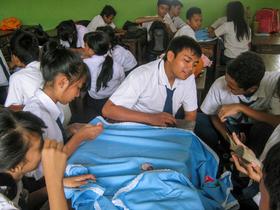Top Rankings
Winona Area Public School District ranks among the top 20% of public school district in Minnesota for:
Category
Attribute
Community Size
Largest student body (number of students) (Top 1%)
For the 2025-26 school year, there are 4 public high schools serving 958 students in Winona Area Public School District. This district's average high testing ranking is 6/10, which is in the top 50% of public high schools in Minnesota.
Public High Schools in Winona Area Public School District have an average math proficiency score of 32% (versus the Minnesota public high school average of 36%), and reading proficiency score of 52% (versus the 51% statewide average).
Public High School in Winona Area Public School District have a Graduation Rate of 86%, which is more than the Minnesota average of 83%.
The school with highest graduation rate is Winona Senior High School, with 90-94% graduation rate. Read more about public school graduation rate statistics in Minnesota or national school graduation rate statistics.
Minority enrollment is 24% of the student body (majority Hispanic and Black), which is less than the Minnesota public high school average of 37% (majority Hispanic and Black).
Overview
This School District
This State (MN)
# Schools
8 Schools
1,171 Schools
# Students
2,378 Students
309,919 Students
# Teachers
170 Teachers
18,769 Teachers
Student-Teacher Ratio
14:1
14:1
Student By Grade
District Rank
Winona Area Public School District, which is ranked within the bottom 50% of all 520 school districts in Minnesota (based off of combined math and reading proficiency testing data) for the 2022-2023 school year.
The school district's graduation rate of 86% has increased from 79% over five school years.
Overall District Rank
#306 out of 525 school districts
(Bottom 50%)
(Bottom 50%)
Math Test Scores (% Proficient)
39%
46%
Reading/Language Arts Test Scores (% Proficient)
41%
51%
Science Test Scores (% Proficient)
35%
41%
Graduation Rate
86%
84%
Students by Ethnicity:
Diversity Score
0.46
0.57
% American Indian
n/a
2%
% Asian
4%
7%
% Hispanic
9%
11%
% Black
7%
11%
% White
72%
63%
% Hawaiian
n/a
n/a
% Two or more races
8%
6%
All Ethnic Groups
District Revenue and Spending
The revenue/student of $21,014 is higher than the state median of $17,860. The school district revenue/student has grown by 10% over four school years.
The school district's spending/student of $20,010 is higher than the state median of $18,585. The school district spending/student has grown by 10% over four school years.
Total Revenue
$50 MM
$15,547 MM
Spending
$48 MM
$16,179 MM
Revenue / Student
$21,014
$17,860
Spending / Student
$20,010
$18,585
Best Winona Area Public School District Public High Schools (2025-26)
School
(Math and Reading Proficiency)
(Math and Reading Proficiency)
Location
Quick Facts
Rank: #11.
Winona Area Learning Center
Alternative School
(Math: <50% | Reading: <50% )
Rank:
Rank:
7/
Top 50%10
1299 West 3rd St
Winona, MN 55987
(507) 494-1461
Winona, MN 55987
(507) 494-1461
Gr: 5-12 | 83 students Student-teacher ratio: 12:1 Minority enrollment: 40%
Rank: #22.
Winona Senior High School
(Math: 30-34% | Reading: 50-54%)
Rank:
Rank:
5/
Bottom 50%10
901 Gilmore Ave
Winona, MN 55987
(507) 494-1504
Winona, MN 55987
(507) 494-1504
Gr: 9-12 | 859 students Student-teacher ratio: 18:1 Minority enrollment: 22%
Rank: n/an/a
Lacrescent Gr 9-12
Alternative School
1301 Lancer Blvd.
Winona, MN 55987
(507) 494-1461
Winona, MN 55987
(507) 494-1461
Gr: 9-12
Rank: n/an/a
Walc Extended Day
Alternative School
1299 W 3rd St
Winona, MN 55987
(507) 494-1460
Winona, MN 55987
(507) 494-1460
Gr: 9-12 | 16 students Minority enrollment: 31%
Recent Articles

Charter Schools vs Public Schools 2025: Key Differences & Trends
Explore updated 2025 insights comparing charter schools vs public schools, enrollment, academic outcomes, funding, and real-world examples for families and educators.

Are Public Schools Ready for the 21st Century? 2025 Update
Explore 2025 insights on whether public schools are ready for the 21st century, covering performance, technology, equity, funding, and future-ready learning.

Public School Open House & Enrollment Season Guide
A parent-focused guide to the public school open house and enrollment season, with expert questions, timelines, and decision tips.





